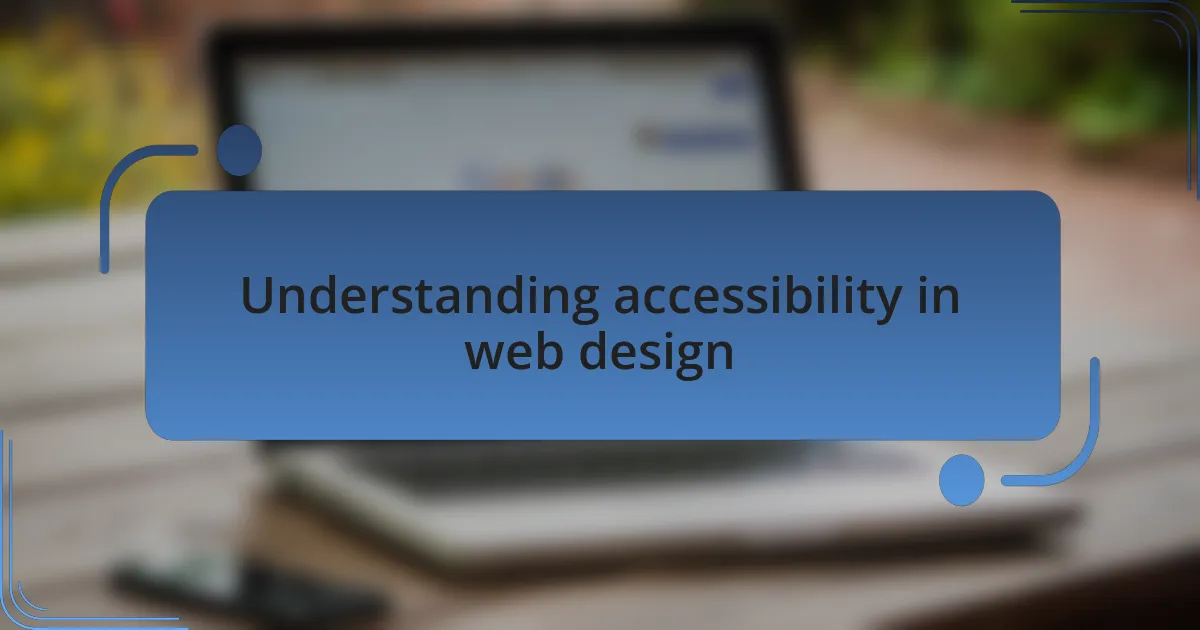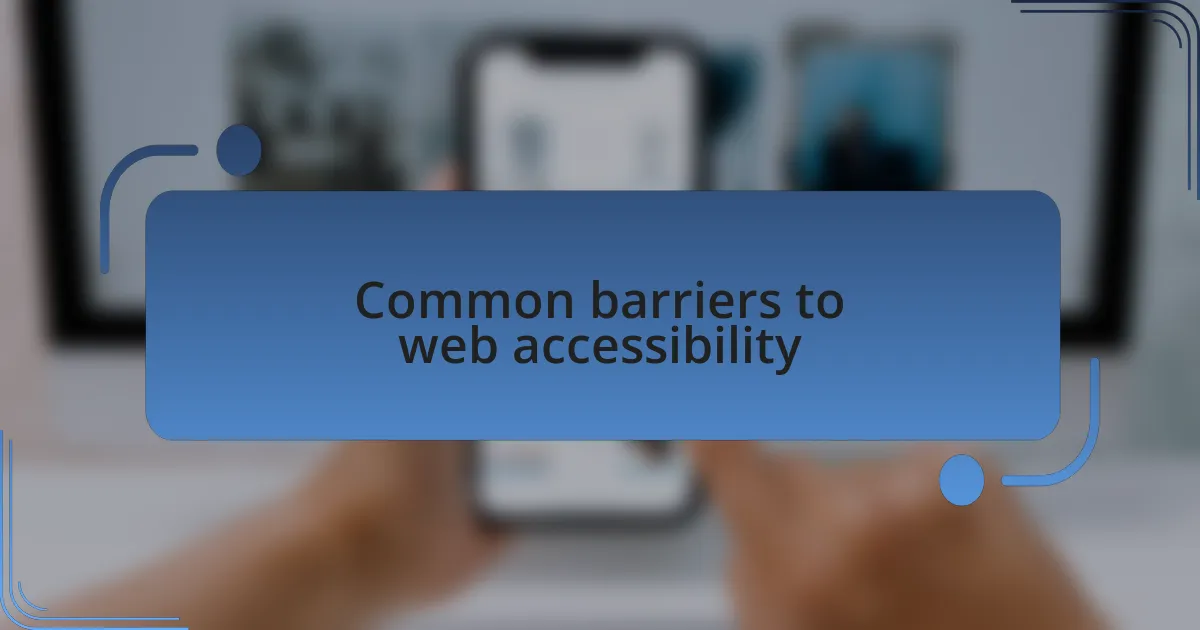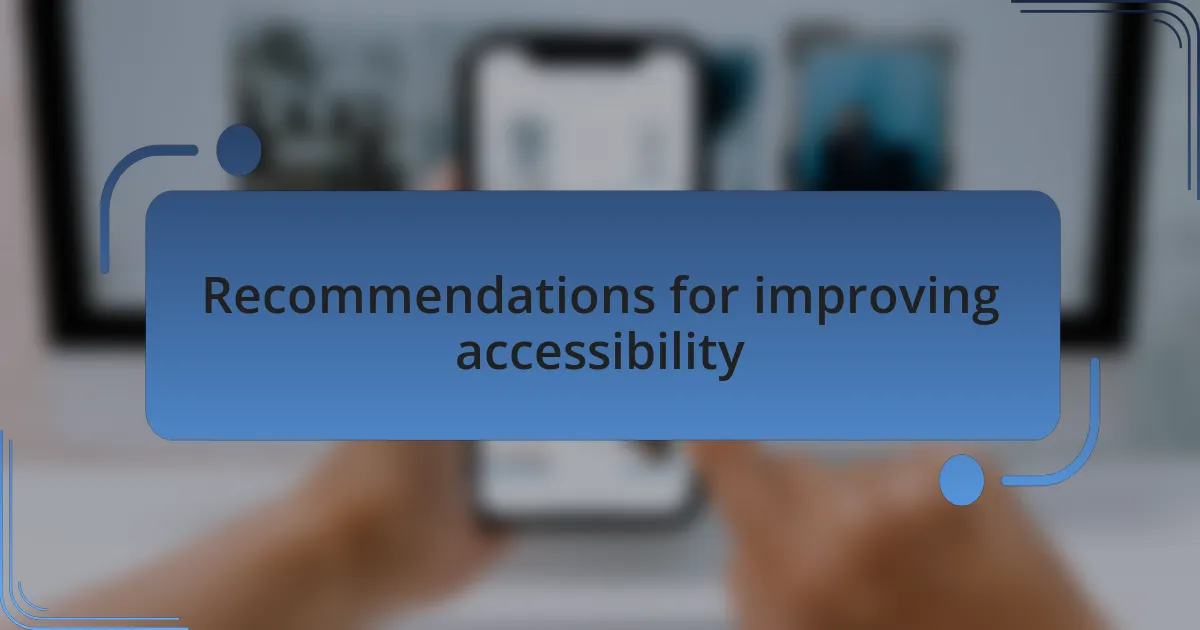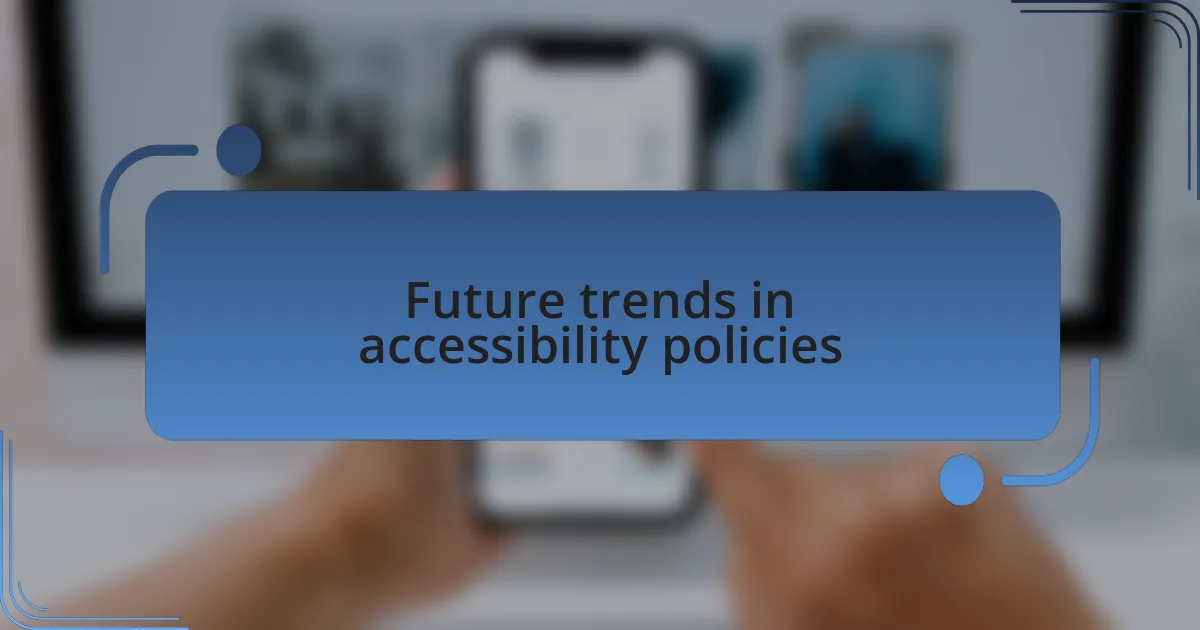Key takeaways:
- Accessibility in web design is essential for creating inclusive experiences for all users, which can enhance overall effectiveness and creativity.
- Government accessibility policies set critical standards that protect users and ensure organizations prioritize inclusivity.
- Common barriers to web accessibility include lack of awareness, outdated technology, and complex navigation, which can lead to significant user frustration.
- Future trends point toward AI-driven solutions, continuous compliance, and personalized accessibility features to further enhance digital inclusivity.

Understanding accessibility in web design
Accessibility in web design isn’t just a checkbox to tick off; it’s about creating a web experience for everyone, regardless of their abilities. I remember a time when I was working on a project for a non-profit organization. We focused on making the site accessible for users with visual impairments. Implementing alt text for images and ensuring that our color contrasts met accessibility standards transformed the site into a welcoming space for all.
Have you ever thought about how frustrating it must be for someone with a disability to navigate a poorly designed website? Personally, I’ve seen firsthand the barriers created by inaccessible design. When I conducted user testing with individuals who had various disabilities, their feedback opened my eyes to how simple tweaks—like ensuring keyboard navigability and using clear headings—can drastically improve user experiences. It was a humbling experience that reinforced the importance of considering all users during the design process.
Incorporating accessibility principles into web design also fosters creativity. I often find that working within these guidelines challenges me to think differently about layout and content presentation. For instance, using simple language not only helps those with cognitive disabilities but also makes the information more digestible for everyone. By embracing these principles, I’ve not only made my designs more inclusive but also enhanced their overall effectiveness. Don’t you think that a website that welcomes everyone is a more successful website?

Importance of government accessibility policies
Government accessibility policies are vital because they set uniform standards that ensure web content can be navigated and understood by everyone. I recall a project where we had to align with these regulations for a government agency’s site. The rigorous guidelines made us rethink our design choices, ultimately creating a more functional and inclusive space that served a greater audience.
Consider the impact of not having these policies in place: millions of citizens could be left without vital information or services simply because their needs weren’t prioritized. This experience reminded me of a workshop I attended where we met individuals whose daily lives were affected by digital barriers. Their stories were powerful, reinforcing my belief that accessibility isn’t just a technical requirement; it’s a moral obligation.
Furthermore, these policies not only protect users but also encourage businesses to embrace inclusivity as a core value. When I see my peers investing time in accessibility, I feel hopeful about the direction of web design. It’s inspiring to know that every effort can create ripples of change, fostering environments that respect and uplift all voices. Isn’t it our responsibility as designers to advocate for those who might otherwise be overlooked?

Common barriers to web accessibility
Web accessibility often faces hurdles that can be frustrating to navigate. One significant barrier is the lack of awareness among designers and developers about specific accessibility needs. I vividly remember a time when I was working on a project and realized that color contrast ratios were overlooked. After running the necessary tests, it became clear how much impact this simple oversight could have on users with visual impairments. It left me wondering how many others might be struggling with similar issues, unaware of the fixes that could dramatically improve their experience.
Another common issue stems from outdated technology. While I often find myself embracing new tools, there’s a surprising number of sites still relying on legacy systems that are not compatible with screen readers or other assistive technologies. It makes me think about the users who are left in the dark, unable to access critical information because of someone else’s reluctance to adapt. When I had to redesign a site that used such outdated tech, the challenge was not just in making it functional but in realizing how many people were affected by these decisions.
Finally, complex navigational structures can serve as a significant barrier. Navigating poorly designed menus can be a daunting task, especially for those with cognitive disabilities. I recall a user testing session where we observed first-hand how easily frustration could set in. It really struck me how something as simple as clear labeling and a logical flow could ease that tension. Why should anyone feel overwhelmed when they just want to access information? Such straightforward changes in design can provide not just easier access, but also dignity to all users.

My experiences with accessibility policies
My experiences with accessibility policies have not only shaped my understanding of web design but have also challenged me on a personal level. I recall a project where we had to meet specific government accessibility guidelines. Initially, I felt overwhelmed by the strict requirements, but as we dove deeper, I realized the profound difference these policies made. It became evident that adhering to these standards wasn’t just about compliance; it was about creating an inclusive digital space where every user could engage comfortably.
During a workshop focused on accessibility policies, I had an eye-opening conversation with an individual who relied on screen readers to navigate websites. They shared stories of persistent frustration due to unoptimized layouts and clunky navigation systems. This interaction resonated with me and made me reflect on how easily we can take seamless access for granted. How many potential users are we inadvertently excluding by neglecting these policies? It lit a fire in me to advocate for more inclusive practices in all my projects.
Looking back, I remember a time when I felt the pushback from clients regarding accessibility investments. Their concerns often centered around costs and perceived inconvenience. However, I’ve learned that these investments can yield significant returns, enhancing user experience and expanding audience reach. It’s rewarding to see a project flourish when accessibility is prioritized, turning initial resistance into enthusiastic support. Why should anyone settle for less when the web can be a place for everyone?

Recommendations for improving accessibility
To improve accessibility, one of the first steps I recommend is to incorporate user testing with individuals who have disabilities. During one of my past projects, we brought in a group of users with different abilities to test the site. Their feedback was invaluable; they pointed out issues I’d never considered, highlighting how even small tweaks could vastly improve their experience. Asking users directly can lead to genuine insights and transform an ordinary website into an inclusive one.
Another effective approach is to prioritize clear and concise language throughout the site. I remember revamping a page that had technical jargon, which was beautifully designed but completely lost many users. Simplifying the text not only made the content more digestible for everyone but also helped those with cognitive disabilities to comprehend the information quickly. Are we really serving our audience if our language stands in their way?
Lastly, ensuring that all media elements are accessible should be high on the priority list. I once worked on a site that included videos without captions. After a heated discussion with a colleague about the importance of inclusivity, we decided to add subtitles. The positive response from users who benefited from these features was a powerful reminder that accessibility enhances everyone’s experience, not just those with disabilities. Who wouldn’t want to make their content available to the largest possible audience?

Future trends in accessibility policies
As I look toward the future of accessibility policies, I anticipate a stronger push for AI-driven solutions. During a recent project, we experimented with a machine learning tool designed to analyze user interactions. It was fascinating to see how these insights could identify barriers I hadn’t even noticed—introducing automated accessibility checks could save countless hours and improve site usability substantially. Could AI be the key to a more inclusive digital landscape?
Another trend I see on the horizon is the shift towards continuous compliance rather than one-time audits. I remember completing an accessibility audit on a government website, and while it felt like a milestone, the reality hit me hard when I noticed many of those recommendations were ignored shortly afterward. Implementing an ongoing review process will not only ensure that policies are adhered to but also foster a culture of inclusivity within organizations. After all, isn’t accessibility a commitment that extends beyond mere compliance?
Finally, I foresee a growing emphasis on personalized accessibility features. I once worked with a visually impaired client who shared how often he felt like a burden when asking for specific adjustments. It was a stark reminder that every user has unique needs, and technology must evolve to cater to these variations. Can we imagine a future where websites adapt in real-time to provide a customized experience for each individual user? That could be the breakthrough we need for true digital inclusivity.